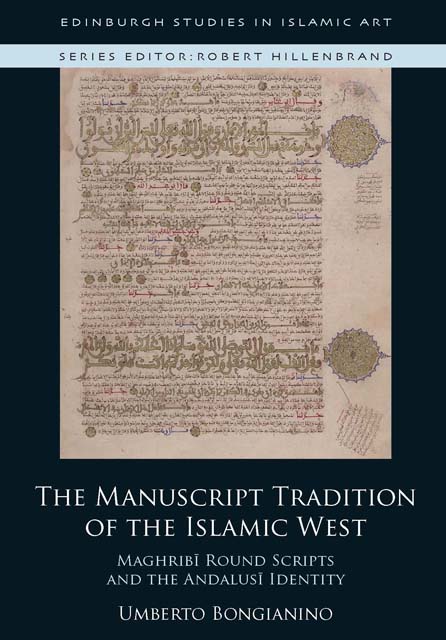Book contents
- Frontmatter
- Contents
- List of Figures
- Acknowledgements
- Note on Transliteration and Translation
- Abbreviations
- Series Editor’s Foreword
- Introduction: A Book about Books
- Chapter One Maghribī Round Scripts: A New Definition
- Chapter Two Maghribī Round Scripts in the Third/Ninth and Fourth/Tenth Centuries
- Chapter Three Maghribī Round Scripts in the Fifth/Eleventh Century
- Chapter Four Maghribī Round Scripts in the Sixth/Twelfth Century
- Chapter Five Beyond Books: Quranic Manuscripts and Chancery Documents
- Conclusion: Inscribed Identities
- I List of Dated Manuscripts
- II Titles and Genres of Dated Manuscripts
- III Copyists of Dated Manuscripts
- IV Places of Copying
- V Remarkable Colophons and Notes
- Glossary
- Bibliography
- Index
Conclusion: Inscribed Identities
Published online by Cambridge University Press: 18 November 2022
- Frontmatter
- Contents
- List of Figures
- Acknowledgements
- Note on Transliteration and Translation
- Abbreviations
- Series Editor’s Foreword
- Introduction: A Book about Books
- Chapter One Maghribī Round Scripts: A New Definition
- Chapter Two Maghribī Round Scripts in the Third/Ninth and Fourth/Tenth Centuries
- Chapter Three Maghribī Round Scripts in the Fifth/Eleventh Century
- Chapter Four Maghribī Round Scripts in the Sixth/Twelfth Century
- Chapter Five Beyond Books: Quranic Manuscripts and Chancery Documents
- Conclusion: Inscribed Identities
- I List of Dated Manuscripts
- II Titles and Genres of Dated Manuscripts
- III Copyists of Dated Manuscripts
- IV Places of Copying
- V Remarkable Colophons and Notes
- Glossary
- Bibliography
- Index
Summary
IT IS THANKS to the early modern historian al-Maqqarī – once again – that the memory of a telling episode that occurred in Almohad Seville at the beginning of the seventh/thirteenth century has been preserved and transmitted. The protagonist of this anecdote is a scholar and member of an aristocratic family from nearby Niebla, Abū al-Khaṭṭāb Ibn al-Khalīl al-SakËnÈ (d. 652/1254). The setting is the old Umayyad mosque of Ibn ʿAdabbas, the first congregational mosque of Seville. Here, Ibn al-Khalīl reports to have seen a multi-volume copy of the Qurʾān, ‘written in a style resembling the scripts of Kufa, but better, clearer, more splendid, and more skilful’. Noticing Ibn al-Khalīl's wonderment, a Sevillian Quranic reader apparently employed in the mosque, Abū al-Ḥasan Ibn ʿAẓīma, revealed to him that that was the script of Ibn Muqla. He then recited from memory a staple verse in praise of the ʿIrāqī calligrapher, featuring a pun on the word muqla (‘eyeball’):
Ibn Muqla's calligraphy! One beholds it,
and his limbs wish they were his eyeballs.
Finally, Ibn al-Khalīl and Ibn ʿAẓīma proceeded to examine each and every letter of Ibn Muqla's script, measuring them with a small compass (‘bi-l-ḍābiṭ’). As a result, they could ascertain that ‘all letter shapes were consistent in proportion and execution, so that all the alifs tallied exactly with each other, and so did all the lāms, the kāfs, the wāws, and all the other letters’.
There are several reasons why this anecdote can be taken to epitomise the manuscript culture of al-Andalus. Firstly, the two men involved were both religious scholars from important AndalusÈ families, who, like so many of their peers, showed a keen interest in penmanship and, in this particular case, a profound appreciation of the Qurʾān as an artefact. Secondly, it is evident that their education presupposed more than a passing acquaintance with Abbasid culture and its leading exponents, such as the legendary vizier Ibn Muqla, even though neither of them seem to have ever travelled outside the Maghrib. Thirdly, their understanding of the eastern principles of proportioned calligraphy, as well as their confident and successful attempt to prove them empirically, are especially surprising given that the calligraphic tradition of their homeland had developed in a completely different direction from the canons established by Ibn Muqla.
- Type
- Chapter
- Information
- The Manuscript Tradition of the Islamic WestMaghribi Round Scripts and Andalusi Identity, pp. 357 - 367Publisher: Edinburgh University PressPrint publication year: 2022

